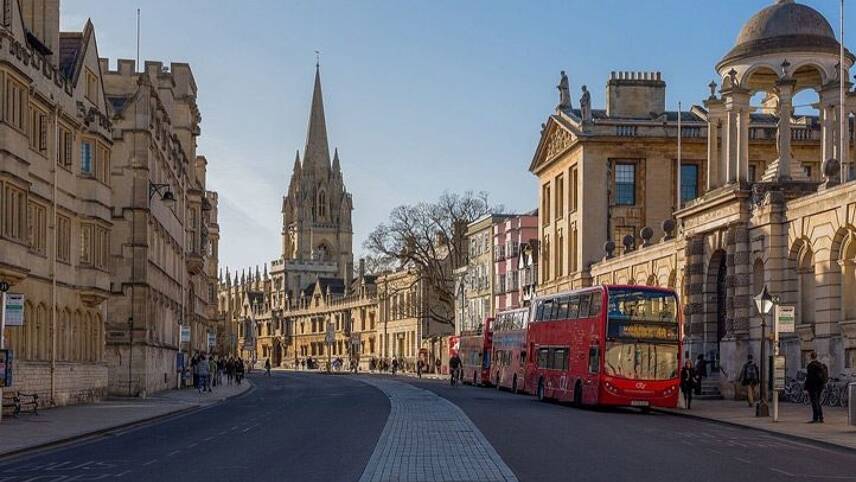Register for free and continue reading
Join our growing army of changemakers and get unlimited access to our premium content

The roadmap divides city-based emissions into five sectors that have the greatest climate impact
The new roadmap for 2040 has been commissioned by Oxford City Council on behalf of the Zero Carbon Oxford Partnership (ZCOP) and developed with the Carbon Trust.
The roadmap breaks down progress to net-zero into carbon budgets covering five-year periods. The science-based roadmap predicts that by 2040, Oxford’s emissions will have been reduced by 88% compared to 2018 levels. If any residual emissions remain in 2040, they would be offset to meet the net-zero target.
The carbon budgets mean that by 2025, emissions will need to be 44.3% lower than in 2018. For 2030, a 63.2% reduction is required and by 2035, a 78.3% reduction will need to be delivered.
Councillor Tom Hayes, Chair of the ZCOP steering group, said: “The Zero Carbon Oxford Partnership commissioned this important piece of science-based research on what needs to be done for the city to achieve net-zero ten years ahead of the national target. Oxford is distinctive for setting such a challenging ambition. This Roadmap is a uniquely detailed and comprehensive tool, that shows us what needs to be done if we are to achieve that.
“We’re transforming our whole way of life. What’s good for the environment will be great for high-skilled jobs in the places where we live, but such change will involve constant citywide conversations, and they will be as challenging and necessary as any we’ve ever had. The partnership will be applying for financial support and grants to ensure that we are able to help residents on this journey and that we are all able to move towards zero together.”
Detailed division
The roadmap divides city-based emissions into five sectors that have the greatest climate impact – domestic, commercial, industry, institutional, and transport.
Domestic emissions would need to be reduced by 87%. According to the roadmap, rooftop solar will need to be added to 20% of existing homes by 2030 and 55% by 2040. Solar will be added to 75% of all new homes from 2030 onwards. Additionally, existing homes will receive at least one energy efficiency measure, reaching more than 48,000 households by 2040.
Commercial emissions need to be reduced by 86% with rooftop solar on commercial buildings to generate 0.9MW of renewable energy by 2025, rising to 6.6MW by 2040 – equivalent to roughly 1500 homes.
Also for commercial, a 10% reduction in electricity demand will be delivered by 2025, rising to 40% by 2040, alongside a reduction in gas by 30% by 2040.
Institutional-related emissions need to fall by the highest margin, at 91%. Rooftop solar on institutional buildings will generate 2.8MW by 2025, rising to 13.1MW by 2040. Electricity demand from this area will be reduced by 35% by 2040 and gas demand will need to fall by 25%.
Emissions from industry will be reduced by 86%. Fossil fuel processes will gradually be electrified, at first by 10% by 2025 then 12% by 2030, 18% by 2035 and 24% by 2040. Industrial energy demand will also fall by 45% by 2040.
Finally, transport emissions will need to be reduced by 88%. By 2025, 25% of cars in Oxford will be EVs, rising to 80% by 2030 and then 100% five years later. A target is in place to introduce more than 570 charging points in workplaces by 2040, complimented by more than 13,000 off-street EV chargers. Additionally, 50% of buses and coaches will be switched to hydrogen by 2040 – accounting for more than 200 vehicles. The promotion of cycling, walking and home-working will also aim to facilitate a 30% decrease in vehicle use by 2040.
Earlier this year, Oxford City Council approved local air pollution targets through to 2025 that are stricter than the national legal target.
In what it claims is a UK first, members of the Council’s cabinet voted this week to approve an Air Quality Action Plan spanning 2021-2025. The Plan is headlined by a commitment to ensure that levels of NO2 are no higher than 30 micrograms per cubic metre of air (30 µg/m3) by the end of 2025.
Currently, the UK Government’s target is to limit NO2 levels to 40 µg/m3. These limits could be altered via the Environment Bill. Oxford City Council said in a statement that it wanted to go further, as some research has concluded that this is not a safe limit. NO2 has repeatedly been linked to reduced lung function and inflammation of the airways.
Oxford City Council is implementing a Zero Emission Zone (ZEZ) in tandem with its work to help businesses, households and public transport bodies to either shift mode of transport or invest in low and zero-emission vehicles
The ZEZ’s first phase – a “Red Zone” in Oxford City Centre – will charge drivers of non-Euro-six-compliant vehicles £10 each time they enter between 7am and 7pm, seven days a week. Residents living within its boundaries will benefit from a 90% discount. A broader “Green Zone” will then be developed.
Trials of the Red Zone were due to start last year, but were delayed due to Covid-19. Oxford City Council now plans to begin the pilot this August.
Matt Mace


Please login or Register to leave a comment.